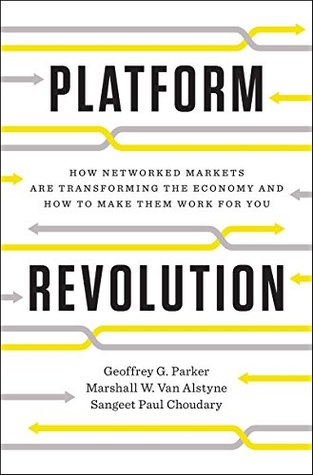More on this book
Community
Kindle Notes & Highlights
Read between
January 20 - February 8, 2020
The three partners started out focusing on events for which hotel space was often sold out,
scoring their first big hit at the 2008 South by Southwest festival in Austin.
siphoned
new business model that uses technology to connect people, organizations, and resources in an interactive ecosystem in which amazing amounts of value can be created and exchanged.
As we’ll explain, practically any industry in which information is an important ingredient is a candidate for the platform revolution.
businesses whose “product” is information
information about customer needs, price fluctuations, supply and demand, and market trends has value—which ...
This highlight has been truncated due to consecutive passage length restrictions.
dabbled
what would happen if a battalion of modern U.S. Marines took on the ancient Roman Empire.
daunting
A platform is a business based on enabling value-creating interactions between external producers and consumers.
open, participative infrastructure for these interactions and sets governance conditions for them. The platform’s overarching purpose: to consummate matches among users and facilitate the exchange of goods, services, or social currency, thereby enabling value creation for all participants.
In the process, they exchange, consume, and sometimes cocreate something of value.
than flowing in a straight line from producers to consumers, value may be created, changed, exchanged, and consumed in a variety of ways and places, all made possible by the connections that the platform facilitates.
Platforms beat pipelines because platforms scale more efficiently by eliminating gatekeepers.
In the traditional publishing industry, editors select a few books and authors from among the thousands offered to them and hope the ones they choose will prove to be popular.
Consulting and law firms are also in the business of selling bundles.
order to gain access, they must also purchase the services of relatively junior staff at high markups.
unlock new sources of value creation and supply.
return, Airbnb takes a 9–15 percent (average 11 percent) transaction fee for every rental arranged through the platform.
may take years for a hotel chain to select and purchase a new piece of real estate, design and build a new resort, and hire and train staff. By contrast, Airbnb can increase its “inventory” of properties as quickly as it can sign up users with spare rooms to rent.
Thus, platforms disrupt the traditional competitive landscape by exposing new supply to the market.
Before the rise of the platform, it might have been possible to loan something to a family member, close friend, or neighbor, but much harder to loan to a stranger. This is because it would be difficult to trust that your home would be left in good shape (Airbnb), your car would be returned undamaged (RelayRides), or your lawnmower would come back (NeighborGoods).
using data-based tools to create community feedback loops.
contrast, traditional pipeline firms rely on mechanisms of control—editors, managers, supervisors—to ensure quality and shape market interactions.
Strategy has moved from controlling unique internal resources and erecting competitive barriers to orchestrating external resources and engaging vibrant communities.
platform’s overarching purpose is to consummate matches among users and facilitate the exchange of goods, services, or social currency, thereby enabling value creation for all participants.
they don’t own or control, they can grow much faster than traditional businesses.
their value from the communities they serve.
In traditional businesses, both are delivered through linear value chains—pipelines—
seemingly
arcane
hubris.
forthrightness,
Network effects refers to the impact that the number of users of a platform has on the value created for each user.
Unaware
By contrast with supply economies of scale, demand economies of scale take advantage of technological improvements on the demand side
efficiencies in social networks, demand aggregation, app development, and other phenomena that make bigger networks more valuable to their users.
Arguably, it had zero value, because when there’s only one telephone in the world, you can’t call anyone.
(Working in reverse, it explains the convex collapse of Blackberry in the 2000s: as users began to flee the Blackberry platform, the loss of network nodes caused the value of the network itself to plummet, encouraging still more people to abandon Blackberry for other devices.)
market share as practically the only significant metric of business success.
They arise when people come to associate a particular brand with quality. But brand effects, like price effects, are often difficult to sustain.
But only network effects create the virtuous cycle we described above, which leads to the building of a longlasting network of users—a phenomenon we called lock-in.
Derived from the expression “going viral,” virality is the tendency of an idea or brand to be circulated rapidly and widely from one Internet user to another.
people who are off the platform and enticing them to join it, while network effects are about increasing value among people on-platform.
Curious about what separated the successful companies from those that failed, we examined dozens of cases and found that the failures mostly relied on price or brand effects.
By contrast, Google found a way to serve web page searchers by harnessing the work of web page producers.
Scaling a network requires that both sides of the market grow proportionally.
Uber driver can serve an average of about three Uber riders an hour.
The growth of a network can produce negative network effects that drive away participants, even leading to the death of a platform business.


